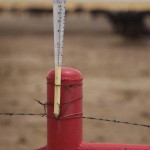0.01% of Texas is No Longer in Drought

Map by National Drought Mitigation center
A map shows the 0.01 percent of Texas no longer in drought.
Christmas came a little early for a small slice of Texas this year. We can now say that part of Texas is no longer in drought. A small part, to be sure, only 0.01 percent, but it’s happy news nonetheless.
According to new data from the National Drought Mitigation Center at the University of Nebraska (with a grateful hat tip to Kate Galbraith of the Texas Tribune), a sliver of Texas along the Texas-Oklahoma border is officially drought-free. Just east of Paris, Texas, 3.7 percent of Red River County is no longer in drought, representing 0.01 percent of the entire state.
At the beginning of the year, nearly 8 percent of the state wasn’t in drought and none of Texas was at the “exceptional” level of drought. Today, nearly 39 percent of Texas is at the “exceptional” level, the most severe stage of drought.
Put simply, the drought is far from over. Saturday the state climatologist John Nielsen-Gammon wrote on his blog that “it’s hard to break out of a drought when you’re still setting records.” Those broken records? He put together a list. So far this year, including estimates for December, Texas has put up the following numbers:
- Driest April-December on record (by ½ inch)
- Driest March-December on record (by ¾ inch)
- Driest February-December on record (by 1 inch)
- Driest January-December (driest calendar year) on record (by ¼ inch)
- Driest fifteen consecutive months on record (by ¾ inch)
He also found that these have been the driest 18-24 months since the 1960s, and the driest 36-60 months since the 1960s. So is there any solace to take from the recent rains? Nielsen-Gammon says yes:
“The rain so far has been great for the soil. As is usual with rain during a drought, the first rains are absorbed by the soil, with very little runoff. Only in the past month have we started to see lake levels rising around the state.”
What does the future hold? It’s weather, so good luck prognosticating, but Nielsen-Gammon took a look at La Niña weather patterns and found that after this recent spell of wet weather, “the large-scale weather patterns will change into a warmer and drier configuration, which should put us back on track with the seasonal outlook and, yes, allow the drought to persist.”
Bah, Humbug!


